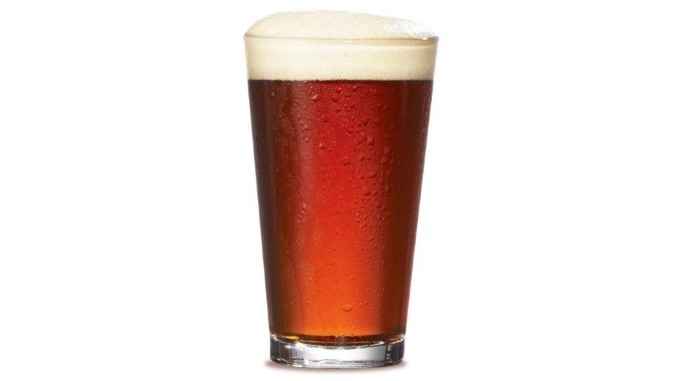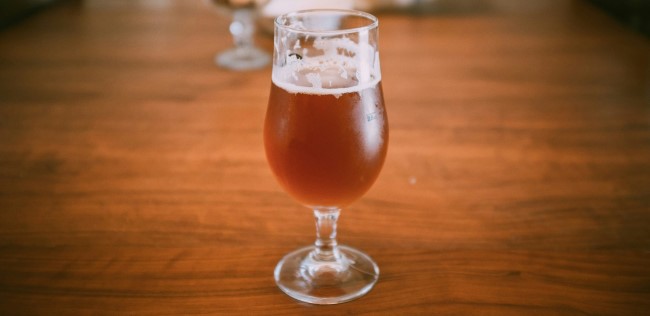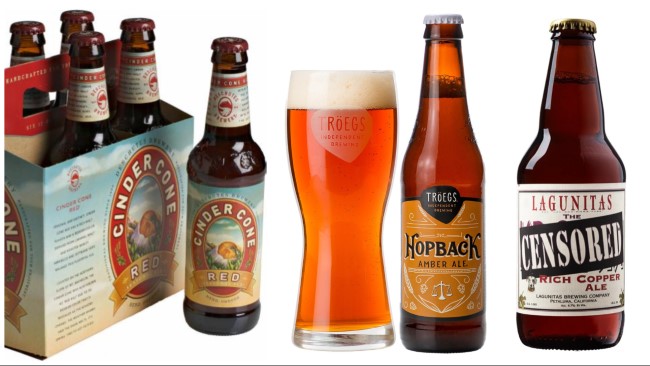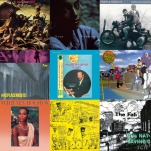Hear Me Out: American Amber Ale
Subscriber Exclusive
Photo via Unsplash, Ashim D’Silva, Giorgio Trovato, Alaskan Brewing Co., Jim Vorel
Hear Me Out is a column dedicated to earnest reevaluations of those cast-off bits of pop-cultural ephemera that deserve a second look. Whether they’re films, TV series, albums, comedy specials, videogames or even cocktails, Hear Me Out is ready to go to bat for any underappreciated subject.
As far as consumer selling points go, the allure of “subtlety” is not exactly an easy one to conceptualize and market. Take a look at the snack foods aisle of a grocery store, and you’ll see what I mean. The “crunchiest” potato chips on the shelf? The selling point there is easily grasped. The “tangiest” or “fruitiest” yogurt or ice cream? Ditto. It’s human nature for the consumer to think in terms of superlatives, because in exchange for our hard-earned money, we by and large believe that we deserve the best version of a product. And it’s an understandable fallacy to naturally believe that “best” is largely going to correlate with “most,” because we humans also want bang for our buck. It’s hard-coded into our behavior in a capitalist economy.
Applied to the world of craft beer, this sentiment is absolutely everywhere in how beer has been marketed in the last decade in particular. India pale ale, the weather vane of the industry, spent an era with brands striving for “most bitter” before the hazy revolution pushed us head over heels into the quest for “most juicy.” Breakfast cereals and candies worked their way into the world of imperial stout, until most every release now attempts to make the selling point its over-the-top employment of vanilla, or chocolate, or marshmallow, or Oreos, or … who knows. Even for the less intense styles, such as light lagers, the race became to create “the crispest,” “the cleanest,” or the lowest in carbs or calories. The point is that along the way, this process largely obliterated the idea that a craft brewery would successfully market a widely distributed beer by simply telling the consumer “Hey, it’s subtle and balanced.” And few beer styles have been hit harder by that reality than the likes of American amber ale.
Years ago, if I was writing a piece about amber ale, I probably would simply have assumed that anyone reading said essay would know exactly what I’m talking about. In 2024, though, that can no longer be taken for granted. A person who discovered craft beer in the last five years or so really might not come across amber ale very often at this point, particularly if they’re frequenting brewery taprooms opened during that same era. So let me first define what we’re talking about, drawing on a universal resource, and a definition clearly written a decade or more ago:
The American amber ale is one of the most widely enjoyed styles throughout the United States and serves as a cornerstone style of the American craft brewing revolution. American ambers are darker in color than their pale ale cousins, the presence of caramel and crystal malts lending a toasted, toffee flavor, along with the perception of a fuller body when compared to beers without such malts. Amber beer showcases a medium-high to high malt character with medium to low caramel character derived from the use of roasted crystal malts. The American amber is characterized by American-variety hops, which lend the amber ale notes of citrus, fruit and pine to balance the sweetness of the malt.

An American amber ale, then, is a beer style defined by its “middle of the road” nature, being moderate in ABV (between 4-6% or so), and moderately assertive in both malt and hop flavors. They’re more malt forward than classical American pale ale, but less so than the next step on the color wheel, brown ale. Likewise, they’re more hop-forward than the typical brown ale or porter, but not as defined by hop flavors as pale ale. Everything about amber ale–or “red ale,” which functionally means the same thing to most breweries–falls neatly into the valley between other styles. Which of course means you can’t really take any of these elements to an extreme, because too much or too little malt or hop presence would render a beer that is closer to another style than it is amber ale. The balance between the two is the entire spirit of the thing.
And balance? That’s something consumers have been either trained to think they don’t want, or something that they don’t even realize can be a virtue in the first place. So, you know, Hear Me Out and all: You should give a chance to a craft beer style like amber ale, not only for its own charms, but for the more measured and subtle approach it represents. Developing a taste for these kinds of beers might well open your palate to other, delicate flavor experiences that you might once have simply dismissed as “boring.” And for a drinker who almost exclusively consumes, say, sticky-sweet hazy IPA or pastry stout, this can be a gratifying stage in one’s beer journey. Who knows, you might suddenly find yourself developing an interest in the equally endangered brown ale, or unfruited versions of Berliner weisse or German Leipziger Gose, roggenbier, British bitter or the amber lager known as Polotmavý. The beer world may well be bigger than you realize.
To be certain, this is the sort of appreciation that tends to grow slowly over time, and that was certainly the case for me. Years ago, in the mid-2010s, you would no doubt have found me in the camp of drinkers entirely overlooking amber ale as a style, feeling as if I had “graduated” from it or moved past it. This is sort of ironic, given how apt the style is for introducing drinkers to craft beer in the first place–it certainly had played such a role for me in the mid-2000s. In the decade that followed, however, American beer styles became bigger and bolder. A constant pursuit of novelty pushed drinkers like myself away from staid tradition and toward the latest and greatest thing. It’s no surprise that amber ale suffered while many craft beer geeks went through similar phases.
Today, though, I find my appreciation renewed for many classical beer styles, amber ale included. I admire the delicate interplay between malt and American hops, and it’s almost novel at this point to experience hop flavors in a way that is restrained, rather than bombastic and in-your-face. A depth of subtly sweet, biscuity, toasty malt flavor has likewise become more of a rarity as the entire industry shied away from the use of crystal malt, once ubiquitous in everything from IPA to porter and stout. These styles of malt were once one of the defining flavors of the entire American craft beer experience, but now you have to go out of your way to find them. They provide a roundness and gentle sweetness that is very much unlike the more blatant, straight-to-the-point sweetness found in so many modern hazy IPAs or stouts. “Round” is one of the go-to words for the style, in fact, because the archetypal amber ale is the sort of beer without any sharp corners or obtrusive flavors.
At the end of the day, a well-made American amber ale is simply the epitome of a comforting pint of beer. They’ve always been cited as among the most “food friendly” beer styles for a reason, because the general subtlety of their flavors means an amber ale doesn’t feel odd to pair with most dishes. Burgers, pizza, chicken wings, pretzels, any kind of pub grub–that’s the home base of amber ale. Try to sample one with an open mind, particular if it’s been a long time since you last approached the style.
Amber Ale in Retreat
Now, the bad news: Finding many widely available examples of this style in distribution is likely to be more difficult than ever for the average consumer. And this is hardly a new phenomenon, as the decline of amber ale has been steadily underway for more than a decade. I’ve even banged on about it before: It was a full five years ago, in 2019, that I first wrote an essay on amber ale as an “endangered beer style.” Now in 2024, I thought it would be interesting to revisit the state of the industry in 2019 vs. now, and see what if anything has continued to change for American amber ale.
When I wrote that piece, I noted something that would effectively become my thesis now, when it comes to the lack of consumer appreciation/recognition for subtlety in craft beer. Looking at the highest-rated expressions of the “American Amber/Red Ale” category on Untappd, something stark stands out: All of the beers with the highest ratings should really be categorized as different styles. The top two, from 3 Floyds and Tree House, are essentially both IPAs in terms of ABV range and hop strength, that just happen to be colored red. The next is a 12% ABV barrel-aged beer from Allagash, meant to replicate a Manhattan cocktail. The next is a maple bourbon barrel-aged beer. And so on, and so on. The list of the “best” entries in this style contains plenty of red-colored IPA, imperial barrel-aged beer, and heavily adjunct brews made to taste like apple pie, sweet potato or maple syrup. But what it doesn’t contain is American amber ale, because the average consumer using a rating system like Untappd, which helps to form and consolidate beer geek opinion/groupthink, simply doesn’t consider that style worthy of a high score even when it’s the most perfectly executed example of that style in the world. It still loses out to something called “Bourbon Barrel Aged Wood Drip Maple Amber.”
With that kind of widespread attitude having only intensified in recent years, is it any wonder that more traditional amber ale has continued a precipitous decline? Look no further than the specific brands I highlighted when writing that piece in 2019. At the time of publishing, I attempted to gather a representative list of brewing companies (invariably older ones) that were still producing year-round, bottled/canned and distributed amber ales. I came up with the following: New Belgium, Alaskan Brewing, Bell’s, Troegs, Deschutes, Rogue, Anderson Valley, Lagunitas, North Coast, Highland, and Abita. And I wondered: How many of those beers still exist, and are still in distribution?
There are a handful that have persevered. Alaskan Amber is still the indispensable company flagship, having become one of the most lauded standard bearers for this style. Anderson Valley’s Boont Amber is still hanging on, though the company’s beer finder places the closest cans to my actual address as being 60 miles away. Highland Brewing Co., North Coast Brewing and Abita are still producing their amber ales as core selections of the lineup. And Bell’s Amber, once upon a time the flagship of the entire company, still does exist as a year-rounder, though you’re likely to have a lot more trouble finding it than you once did. Case in point: Bell’s beer is sold at more than 25 stores and markets in my immediate area, but exactly one of them carries Bell’s Amber thanks to the far greater amount of shelf space at Total Wine. That means the brand functionally ceases to exist anywhere that the consumer is dependent upon grocery stores, gas stations, etc for beer buying. That fight for shelf space continues to shuffle the style out of sight.

Functionally deceased amber ale brands you’ll no longer see in distribution.
Other amber ale brands from that 2019 list, meanwhile, have gone the way of the dodo, or been reduced in scope to the point that they only remain in symbolic fashion. Troegs Hopback Amber, a longtime core offering and GABF gold medalist, is now a brewery taproom exclusive that the company doesn’t put into cans or bottles. Deschutes discontinued their Cinder Cone Red, replacing it with a seasonal they call a “northwest pale ale” that happens to be red in color. Rogue American Amber Ale, the second-ever beer created by brewmaster John Maier, has long since left any form of distribution, though it may still exist as a taproom exclusive. Lagunitas had a long history selling amber ale, and a classic story to go with it–their original “copper ale” Kronik was a core fixture of the lineup for many years, and had its name changed to “Censored” when the cannabis-inspired reference earned them the ire of the TTB. But that history didn’t stop Lagunitas from quietly shuffling Censored into the “gone but not forgotten” section of the website a couple years back, where they memorialize discontinued beers.
And then there’s New Belgium Fat Tire, undoubtedly the highest profile example of how a struggling beer market has reframed its relationship with amber ale. After decades of being the company’s most visible and famous symbol, and the source of its iconic bicycle iconography, Fat Tire had its recipe unceremoniously changed last year when the classic amber ale was reimagined as a “crisper” and “brighter” golden ale. The change didn’t seem to go over well, but the company no doubt viewed it as a damned-if-you-do, damned-if-you-don’t scenario. The classic, amber version of Fat Tire had been slowly bleeding out market share for years and years, long since supplanted as the company’s actual flagship product by the entire Voodoo Ranger line of IPAs. The choice was to either let Fat Tire’s decline continue organically, or to radically refresh the brand in hopes of courting new drinkers, even though this was likely to upset the remaining faithful ones. New Belgium weighed those options and decided that ditching more than 30 years of Fat Tire’s identity was the way to go. Does that not make clear just how dire things are out there in the craft beer industry?

In short, in the five years since my previous amber ale screed, the decline of such tertiary craft beer styles has continued apace, and it’s difficult to say what would even need to happen to reverse that kind of momentum after all this time. Perhaps the growing interest in craft lager could lead to a greater development of appreciation for subtlety in the average consumer, and that could lead to a gradual reevaluation or rediscovery of styles such as amber ale? Or perhaps the remaining brands on that prior list are running on borrowed time.
It feels absurd, on the face of it, to warn that something like Alaskan Amber Ale or Bell’s Amber could eventually go extinct–particularly for those of us who came up as craft beer geeks from the 2000s onward, and have seen these brands as immovable standard bearers. But two years ago, would you have believed that Fat Tire would be swapped out for a lighter, more approachable beer after 33 years on the market? There comes a time when nostalgia just isn’t enough to shield any brand from the realities of profit and loss. And so, if this is a style that you harbor any appreciation for at all, you might want to celebrate amber ale now, while you still have the option.
Jim Vorel is a Paste staff writer and resident genre geek. You can follow him on Twitter for more film and TV writing.






































